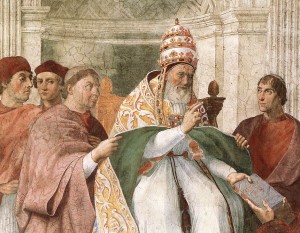The Church and the Jews
Medieval Europe—like modern Europe—was a potpourri of diverse topographies, climates, languages, ethnicities, and cultures. Unlike modern Europe, however, Europe of the Middle Ages was unified by broad commitment to Christianity and general acceptance of the authority of the Roman Catholic Church. Thus, the Church played a unifying and central role in the fate of medieval European Jews.
The medieval Roman Catholic Church inherited and maintained a doctrine that legitimized Jewish presence in medieval western Christendom, while this doctrine simultaneously provided a rationale for wide-ranging infringements on Jewish life. Ecclesiastical policies included protective and restrictive elements. On the one hand, Church leadership regularly insisted on Jewish safety and security and on the right of Jews to live according to their laws and traditions. At the same time, ecclesiastical leadership also called for limitations that would preclude Jewish blaspheming of Christianity and baneful Jewish influence on Christians. While Church doctrine was relatively stable, the policies that flowed from the core doctrine shifted considerably over the medieval centuries, with a noticeable tendency toward increasingly harsh restrictions.
Beyond doctrine and policy, the Church also purveyed imagery of Judaism and Jews that was extremely negative and thereby laid a foundation for the proliferation of increasingly irrational perceptions and stereotypes of Jews, which ultimately served as the basis for outbreaks of popular anti-Jewish violence.
DIG DEEPER:
-
- Overview- The Church and the Jews
- The Roman Catholic Church—Doctrine
- The Roman Catholic Church—Policies—Protection
- The Roman Catholic Church—Policies—Prohibition of Blasphemy
- The Roman Catholic Church—Policies—Segregation
- The Roman Catholic Church—Policies—Economic Limitations
- The Roman Catholic Church—Policies—Missionizing

Pope Gregory IX
What do you want to know?
Ask our AI widget and get answers from this website